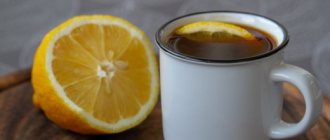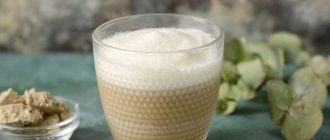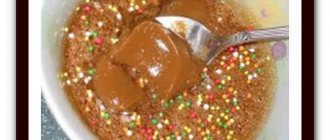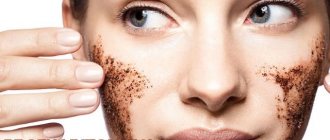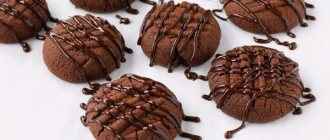No matter how many different ways people prepare coffee! The traditional method of brewing in a cezve (Turk) has long receded into the background. Now, in an age of constant rush, we want to get a drink in a couple of seconds. There are, of course, such barbarians who simply pour boiling water over ground coffee and cover it in a cup for a couple of minutes, like tea. Or use soluble powder. But in this article we will learn how to make espresso coffee. Portions of this drink are small - just a couple of sips. But this coffee is so invigorating, it has a great taste and a delicious, long-lasting crema. The Italians came up with this brewing method. Translated from Dante's language, "espresso" means "squeezed out." That says it all. After all, there are geyser-type coffee makers and old, proven cezves. But in them the drink does not come out so rich, with such a piquant hint of saltiness. Below we will provide a list of different “espressos” and give a recipe for making it at home.
The right approach to choosing ingredients
The quality of the drink that subsequently ends up on your table depends on many factors. Real espresso coffee can, of course, only be made from hand-ground beans. Therefore, every detail is important:
- Type of coffee. For espresso, a mixture of different varieties of Arabica and Robusta is taken. The first is responsible for the rich aroma and attractive foam, the second is responsible for the dense structure and strength of the drink.
- Quality. Take a close look at the external condition of the purchased grains. They should have a slight shine, which is given to them by naturally occurring oils. If the grains are matte, they were probably roasted improperly.
- Storage. The first is tightness, the second condition is shelf life. You should not keep any coffee beans at home for more than 18 months, even in special packaging that prevents them from losing their properties.
- Roasting. Dark roasted beans are suitable for espresso - this is something between medium (for cappuccino) and very dark types of processing.
How to serve espresso
To enjoy a flavorful drink, you need not only to prepare the coffee correctly. Espresso requires a certain delivery. Following several rules will preserve its temperature and taste:
- To serve, use small porcelain cups with thick walls - demitas. Their volume is designed for one serving of drink.
- Before pouring the coffee, warm the cups slightly. You can warm them up either in a coffee machine or by pouring boiling water inside.
- Another important condition: the drink should occupy no more than 2/3 of the volume of the cup, otherwise it will cool down and lose its taste.
The fastest way to make your own espresso
At home, we have two options to create this drink - using a Turk or directly in a coffee cup. Let's start with the last one.
Oddly enough, we will need instant coffee - after all, this is the fastest way to make espresso. Just take the amount of coffee and sugar you're used to using for your morning fix and put it in a cup. Next we will need regular boiling water - add it literally a teaspoon at a time to the container with coffee, while vigorously stirring and whisking.
We are trying to achieve a characteristic light beige color, as well as a consistency reminiscent of thick sour cream. Once this has been achieved, add boiling water on top to create a portion, stir very carefully. Dense white foam will be a signal that everything was done as it should. But, of course, to make truly excellent coffee at home, you need skill and time.
How coffee producers are deceiving us
If you prefer to start your day with the ritual of making coffee, then this article is for you. There is nothing more offensive than, having conjured a Turk or turned on the coffee machine, instead of the drink of the Arab sheikhs, you get a cup of brown liquid. From this material you will learn what determines the quality of coffee, how it is counterfeited, and how to find the best product among hundreds of brightly colored packages.
Classmates
“Crazy hands” - how they make coffee surrogate
Real coffee is very expensive, since the coffee tree is capricious, and its beans ripen for more than six months.
How can manufacturers and sellers resist the temptation to increase the volume of the product through clever counterfeits!? Advertising The most common types of fraud are:
- replacing Arabica with cheaper robusta;
- molding coffee beans from flour, starch, sugar and dyes;
- the use of foreign raw materials - malt, chicory, ground acorns, barley, rye and even millet.
A low-quality drink will manifest itself with an unpleasant taste, foreign odor, or behave in an unexpected way during the preparation process. To avoid disappointment, you need to determine the authenticity of the product before purchasing. Choosing the right coffee - first look at the packaging
Coffee beans are sold by weight or in packages. When weighed by weight, it will always be of worse quality, because under the influence of light and oxygen it slowly oxidizes, losing essential oils, and with them most of the fragrance. When choosing packaged grain, we pay special attention to the tightness of the packaging. The best product comes in three-layer bags with a foil inner layer, a reusable zipper and a valve that works in one direction - out. The valve does not allow oxygen, which is detrimental to their quality, to reach the grains, but allows the buyer to evaluate the nuances of aroma in advance. Medium roast coffee will smell like bread, dark roast coffee will smell like chocolate.
When studying the label, be sure to find the roasting date. The most delicious coffee will be the one that was roasted no more than two weeks ago. The maximum allowable time between roasting and consumption is two months. And then the coffee goes rancid and becomes not only faceless, but also unsafe for health. The most delicious coffee will be the one that was roasted no more than two weeks ago. The maximum allowable time between roasting and consumption is two months. The same rule applies to ground and instant coffee: the more technologically advanced the packaging, the lower the likelihood of fraud. We evaluate it according to the following parameters:
- material – we give preference to glass or tin, we ignore plastic;
- quality of design - no blurry inscriptions, overly bright or too pale colors;
- quality of labeling - expiration date, clear barcode that matches the name of the country of origin.
Ground coffee is often sold in compressed “bricks.” The pack must have perfectly even edges - only a genuine manufacturer cares about the aesthetics of appearance. It is desirable that any packaging does not have transparent “windows” through which ultraviolet radiation reaches the grains. If coffee is packaged in cans, there should be no labels attached to them: all necessary images and inscriptions are applied to the can itself.
How to visually evaluate the quality of coffee
To ensure the authenticity of coffee beans, let's evaluate their appearance. They should be:
- same size. If the manufacturer claims 100% Arabica, the presence of small grains indicates the addition of Robusta;
- whole. The fragments are fried more intensely and subsequently give off pronounced bitterness;
- matte. The shine of the surface and the feeling of its oiliness indicate that the coffee has been sitting for a long time and has begun to release essential oils;
- have no stains. Uneven coloring indicates the presence of mold or an admixture of grains molded from starch; The exception is special melange mixtures of grains of varying degrees of roasting.
If possible, bite through one grain. It should crunch and tickle your tongue with a pleasant taste. The slightest softness and noticeable bitterness indicate spoiled raw materials. If the grain crumbles in your mouth, it is overcooked.
Coffee powder or granules must be absolutely uniform in color. Grains of a different shade are impurities, but if you find white crystals, you have synthetic caffeine from the pharmacy, which is added to the counterfeit for an invigorating effect. We carry out the final authenticity test at home: put a few grains or a pinch of ground in cold water and wait a few minutes. Lack of buoyancy and brown stains will give away “artistic modeling” and impurities. Can we talk about the quality of coffee from bags and sticks?
This is a very convenient package that you can keep ready in your handbag. However, the powder contained in such a bag will never turn into a genuine drink. It is a mixture of low-quality instant coffee with ground chicory, sugar, milk powder and flavorings. And in order for such “pseudo-coffee” to produce foam, modified starch is added to it. Good coffee is worth the money you spend on it. But you should not give them away for an expired or falsified product. When purchasing, pay close attention to the packaging and its contents, and every day will begin with the aroma of an amazing drink.
Share this post with your friends
Classmates
Source
Admin
Classic espresso coffee in Turk
To prepare a 30 ml portion, we will need:
- ground coffee – 2 teaspoons
- sugar – 2 teaspoons
- coarse salt – 2–3 grams
- water
Take a Turk, put the specified amount of coffee in it, then sugar and salt. After mixing these substances, place the container on low heat. The point is to warm up the coffee, so it will give off the necessary aroma and taste. As soon as you feel that a characteristic pleasant smell has begun, add a glass of water. It should be warm to speed up the process. Bring the resulting mixture to a boil.
As soon as bubbles appear, immediately remove the coffee from the heat, pour it into a cup, and then leave it under the saucer for ten minutes. The espresso is ready, you can add toppings as desired.
To make the coffee tasty and aromatic, when heating the dry mixture, keep the Turk a couple of centimeters from the fire, stirring the ingredients regularly.
What a good espresso should look like
A professional barista will instantly recognize a drink prepared in a coffee machine. Real coffee has a stable foam, the thickness of which is at least two millimeters. If you sprinkle a little sugar on top of the foam, the crystals will not sink immediately, but will slowly sink through the dense layer.
Much depends on the type of grains used for cooking. The foam can have different colors: beige, light brown, deep chocolate.
Quality checking
A good drink has a special taste. It contains sweetness, bitterness, slight sourness and saltiness at the same time. In this case, there should be no taste of burnt grains, as well as other foreign flavors.
The aroma of a proper drink should be free of unpleasant odors.
How to serve espresso
Even the most upscale drink should be served according to all the rules:
- For serving, use special cups with thickened walls and bottom. They are called demitas. The volume of one cup is 60 ml. Porcelain is used for production.
- Before pouring the coffee, the demitas should be warmed up a little. You can simply pour hot water into them, or use the function of heating dishes, which is present in many models of coffee machines.
- The drink is not poured to the top; it should fill 2/3 of the demitas.
- You can apply a topping design on top.
Types of espresso and their preparation
Perhaps not everyone will like only the classic version of this invigorating and bright drink. At home, you can prepare several versions of it, depending on the amount of ingredients:
- Actually a classic version. For 30 ml of water, take one teaspoon of finely ground coffee. Prepared according to the previously presented recipe in Turk.
- Doppio. From Italian this word is translated as “double”, that is, all the ingredients of the classic version are doubled, everything is prepared without changing the technology.
- Ristretto. A more “strict” option, when half as much water is taken to make the drink even more rich. Suitable for true connoisseurs of espresso coffee.
- Macchiato. To prepare this variety at home, simply add a little milk on top of the finished drink, brought to a foamy state.
- Lungo. Add the finished coffee with hot water to obtain a volume of 50 ml.
- Konpanna. Pour a standard amount of espresso into a cup. You can optionally add whipped cream, grated chocolate, and lemon zest on top.
- Romano. This citrus option is designed to refresh the coffee and diversify it. A small slice of lemon or orange is simply served with espresso brewed according to the classic recipe.
- Coretto. As an addition, for example, whiskey or liqueur can be used. Moreover, there are special names for such drinks depending on the type of alcohol chosen. Espresso with whiskey is Irish coffee, with vodka is Russian coffee, with schnapps is German coffee, with gin is English coffee. If we take the Italian version, then it is traditionally amaretto.
- Glasse. To prepare it, espresso is brought to a temperature of 10°, and then ice cream, cinnamon, chocolate or caramel are added as desired in proportions of 1:3.
- Cappuccino. A special feature of this type is the abundant milk foam. In Italy, it is customary to drink cappuccino for breakfast. You can add grated chocolate on top.
- Americano. In fact, this is a standard shot of espresso, diluted to the full volume of a coffee kettle. They are usually served in standard cups (120 ml).
- Latte. Here, rather, coffee acts as an addition; the basis is heated milk, into which espresso is poured in a small stream. On top is milk foam.
- Mocha. This is the same latte, only in changed proportions. Espresso and toppings are taken in a ratio of 1:3.
Varieties of espresso
Coffee using the classic steaming method is served in portions of 25-35 ml. Do you want more? Prepare an “espresso doppio”, simply a double portion of the drink. Are you taking care of your liver? Then brew an “espresso lungo”. In this case, only the amount of water increases (60-75 ml). In “espresso-ristretto” it’s the other way around. Pour just a little water: 18-20 ml. In macchiato, we soften the taste of regular espresso coffee with a tablespoon of warm steamed milk. This makes the drink appear “speckled.” In "espresso con panna" (another name for "tazza d'oro" - golden cup) we cover the coffee with a cap of whipped cream. In Romanno (Roman style) add a couple of drops of lemon juice or rub a little zest into a cup. And finally, the evening “corretto” (seasoned). In Italy, grape vodka grappa is added to this drink; outside the Apennine Peninsula, a small amount of liqueur is added.
Coffee Frappe
Brew a shot of espresso in its classic variation and let it cool. To prepare, you will need a glass that can be hermetically sealed, such as a shaker. We pour the prepared coffee there, add a couple of teaspoons of sugar and no more than 5 tablespoons of water.
Close the glass and shake it thoroughly - you should get plenty of foam. Now take a serving glass, a transparent one will look very advantageous. Place a few ice cubes there and pour the resulting coffee foam on top.
If you find the drink too strong, you can add cream or cold milk to taste. All that remains is to mix everything.
Espresso in French press
To avoid damaging the glass, first rinse the glass with hot water. Place four tablespoons of ground coffee in the bottom of the container. As soon as the water in the kettle begins to boil, turn it off and pour in coffee for two servings (500 ml). Do this slowly and carefully.
Then begin vigorously stirring the resulting mixture, and then slightly lower the press filter down. Let the drink steep for about five minutes - the longer, the stronger the coffee. Now slowly lower the filter all the way and pour the espresso into the cups. Be sure to use a strainer.
What is "espresso"
The brewing method involves passing hot water through a layer of ground coffee under a pressure of nine atmospheres. Thus, the extract obtained by infusion comes out. It would seem that it would be easier to prepare a good “espresso” if you have a professional coffee maker. Moreover, stores also sell “tablets” (like tea, ready-made bags packed in paper filters) for such machines. In fact, baristas learn this skill long and hard. Some people also master the art of drawing various intricate designs on the foam of espresso coffee. The Italians, the inventors of this brewing method, believe that for a successful drink you need three favorable factors, three “M”: melange (grains), machine and hand (mano). As you can see, the human factor is not discarded, even if you are the happy owner of an automatic professional coffee maker.
